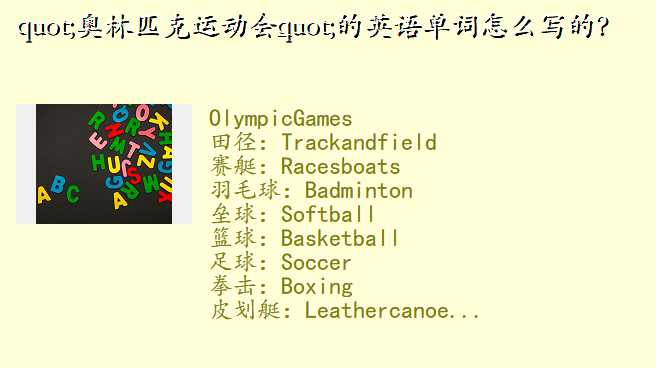目录
- 1,"奥林匹克运动会"的英语单词怎么写的?
- 2,奥林匹克运动会的英文怎么拼
- 3,奥林匹克的英语缩写
- 4,奥林匹克的英文简介
- 5,peak是什么意思
- 6,“鸟巢”的名字是怎样来的?求大神帮助
- 7,奥运匹克的标志是?
- 8,PEAK匹克标志是谁设计的
1,"奥林匹克运动会"的英语单词怎么写的?

Olympic Games
田径:Track and field
赛艇:Races boats
羽毛球:Badminton
垒球:Softball
篮球:Basketball
足球:Soccer
拳击:Boxing
皮划艇:Leather canoe
自行车:Bicycle
击剑:Fencing
体操:Gymnastics
举重:Weight lifting
手球:Handball
曲棍球:Hockey
柔道:Judo
摔跤:Wrestling
水上项目:Aquatic project
棒球:Baseball
现代五项:Modern five items
马术:Horse-riding
跆拳道:Tae Kwon Do
网球:Tennis
乒乓球:Ping pong
射击:Fire
射箭:Archery
排球:Volleyball
铁人三项:Iron man three items
帆船帆板:Sailing ship windsurfboard
2,奥林匹克运动会的英文怎么拼
Olympic Games
田径:Track and field
赛艇:Races boats
羽毛球:Badminton
垒球:Softball
篮球:Basketball
足球:Soccer
拳击:Boxing
皮划艇:Leather canoe
自行车:Bicycle
击剑:Fencing
体操:Gymnastics
举重:Weight lifting
手球:Handball
曲棍球:Hockey
柔道:Judo
摔跤:Wrestling
水上项目:Aquatic project
棒球:Baseball
现代五项:Modern five items
马术:Horse-riding
跆拳道:Tae Kwon Do
网球:Tennis
乒乓球:Ping pong
射击:Fire
射箭:Archery
排球:Volleyball
铁人三项:Iron man three items
帆船帆板:Sailing ship windsurfboard
3,奥林匹克的英语缩写
1国际奥林匹克委员会(简称“国际奥委会”;法语:Comité international olympique,CIO;英语:International Olympic Committee,IOC)是一个非政府性、非盈利性和永久性的国际体育组织;它依照奥林匹克宪章领导奥林匹克运动,为奥林匹克运动会及其五环会徽的专管机构,和领导奥林匹克运动和决定有关奥林匹克运动问题的最高权力机关;对每4年举办一次的奥运会拥有一切权力;它与其成员国或地区,以及国际单项体育组织相互承认。其第一负责人即国际奥林匹克委员会主席,由奥委会全体会议选出,另设副主席4人,委员6名;国际奥委会总部设在瑞士洛桑;工作语言为法语和英语,另外还使用德语、西班牙语、俄语和阿拉伯语。INTERNATIONAL OLYMPIC COMMITTEE[Official site] http://www.olympic.org/2奥林匹克运动会(希腊语:Ολυμπιακο Αγνε,简称奥运会或奥运)是国际奥林匹克委员会主办的包含多种体育运动项目的国际性运动会,每四年举行一次。奥林匹克运动会最早起源于古希腊,因举办地在奥林匹亚而得名。3奥林匹克(Olympic)简称OLY,可指:奥林匹克运动会 the Olympic Games ;奥林匹克精神 the Olympic spirit ;回答版权所有啊,切勿抄袭!!!
4,奥林匹克的英文简介
The flag features the emblem of the Olympic Games — five interlocking rings (blue, yellow, black, green, and red respectively) on a white field. This was originally designed in 1913 by Baron Pierre de Coubertin, the founder of the modern Olympic Games, but gained widespread popularity due to its promotion by Nazi Germany [1]. Upon its initial introduction, de Coubertin stated the following in the August, 1913 edition of Revue Olympique:
The emblem chosen to illustrate and represent the world Congress of 1914 ...: five intertwined rings in different colours - blue, yellow, black, green, red - are placed on the white field of the paper. These five rings represent the five parts of the world which now are won over to Olympism and willing to accept healthy competition.
In his article published in the "Olympic Revue" the official magazine of the International Olympic Committee in November 1992, the American historian Robert Barney explains that the idea of the interlaced rings came to Pierre of Coubertin when he was in charge of the USFSA ( Unión des Societes Française de Sports Athletiques): The emblem of the union was two interlaced rings (like the typical interlaced marriage rings) and originally the idea of Swiss psychiatrist Carl Jung because for him the ring meant continuity and the human being. [2]
“ The Olympic flag [...] has a white background, with five interlaced rings in the centre : blue, yellow, black, green and red [...] This design is symbolic ; it represents the five continents of the world, united by Olympism, while the six colours are those that appear on all the national flags of the world at the present time. ” (1931) Textes choisis II, p.470.
The 1914 Congress had to be suspended due to the outbreak of World War I, but the flag and emblem were later adopted. They would first officially debut at the VIIth Olympiad in Antwerp, Belgium in 1920.
The emblem's popularity and widespread use began during the lead-up to the 1936 Summer Olympics in Berlin. Carl Diem, president of the Organizing Committee of the 1936 Summer Olympics, wanted to hold a torchbearers' ceremony in the stadium at Delphi, site of the famous oracle, where the Pythian Games were also held. For this reason he ordered construction of a milestone with the Olympic rings carved in the sides, and that a torchbearer should carry the flame along with an escort of three others from there to Berlin. The ceremony was celebrated but the stone was never removed. Later, two British authors Lynn and Gray Poole when visiting Delphi in the late 1950´s saw the stone and reported in their "History of the Ancient Games" that the Olympic rings design came from ancient Greece. This has become known as "Carl Diem's Stone". [3] [4]. This created a myth that the symbol had an ancient Greek origin. The rings would subsequently be featured prominently in Nazi images and theatrics in 1936 as part of an effort to glorify the Third Reich and claim a noble and ancient lineage.
The current view of the International Olympic Committee is that the flag "reinforces the idea" that the Olympic Movement is international and welcomes all countries of the world to join. [5] Some literature, such as "The World Encyclopedia of Flags" by Alfred Znamierowski, state that each ring represent the five continents. Using this scheme, the Americas are viewed as a single continent, and Antarctica is omitted.
As can be read in the Olympic Charter, the Olympic symbol represents the union of the five continents and the meeting of athletes from throughout the world at the Olympic Games. However, no continent is represented by any specific ring. Though colourful explanations about the symbolism of the coloured rings exist, the only connection between the rings and the continents is that the number five refers to the number of continents.
参考资料:en.wikipedia.org/wiki/Olympic_rings
5,peak是什么意思
名词 n. [C]
1.山顶,山峰;(有尖峰的)山
The mountain peak was covered with snow.
山顶被雪覆盖着。
2.高峰,顶端,最高点
Tourism is at its peak in August.
八月是旅游高峰。
3.(物体的)尖端
4.帽舌
He wore a black cap with the peak pulled down low over his eyes.
他带一顶黑帽子,帽舌拉得低低的一直盖到眼睛。
及物动词 vt.
1.使尖起,使成峰状
2.使达到高峰
不及物动词 vi.
1.达到高峰
Unemployment peaked at 8.1% in June.
六月份失业率达到了百分之八点一的高峰。
2.耸起
Beat the egg whites until they peak.
把蛋白打到它们耸起。
形容词 a.
1.最高的,高峰的[B]
Traffic is very heavy at peak hours.
在高峰时间交通非常拥挤。
以下结果来自互联网网络释义
peak
1.最高的,高峰
peak 最高的,高峰的
2.峰值,最大值,波峰
peak 峰值,最大值,波峰
3.山顶;山峰
peak 山顶;山峰
6,“鸟巢”的名字是怎样来的?求大神帮助
鸟巢 北京2008奥运会开幕式的体育场馆! “鸟巢”外形结构主要由巨大的门式钢架组成,共有24根桁架柱,现已完成20根桁架柱整柱及2根下柱吊装。此外,屋顶内环主桁架吊装和立面次结构安装已全面展开。“鸟巢”钢结构所使用的钢材厚度可达11厘米,以前从未在国内生产过。另外,在“鸟巢”顶部的网架结构外表面还将贴上一层半透明的膜。使用这种膜后,体育场内的光线不是直射进来的,而是通过漫反射,使光线更柔和,由此形成的漫射光还可解决场内草坪的维护问题,同时也有为座席遮风挡雨的功能。 许多看过“鸟巢”设计模型的人这样形容:那是一个用树枝般的钢网把一个可容10万人的体育场编织成的一个温馨鸟巢!用来孕育与呵护生命的“巢”,寄托着人类对未来的希望。 整个体育场结构的组件相互支撑,形成网格状的构架,外观看上去就仿若树枝织成的鸟巢,其灰色矿质般的钢网以透明的膜材料覆盖,其中包含着一个土红色的碗状体育场看台。在这里,中国传统文化中镂空的手法、陶瓷的纹路、红色的灿烂与热烈,与现代最先进的钢结构设计完美地相融在一起。 整个建筑通过巨型网状结构联系,内部没有一根立柱,看台是一个完整的没有任何遮挡的碗状造型,如同一个巨大的容器,赋予体育场以不可思议的戏剧性和无与伦比的震撼力。这种均匀而连续的环形也将使观众获得最佳的视野,带动他们的兴奋情绪,并激励运动员向更快、更高、更强冲刺。在这里,人,真正被赋予中心的地位。 更为匠心独具的是,“鸟巢”把整个体育场室外地形微微隆起,将很多附属设施置于地形下面,这样既避免了下挖土方所耗的巨大投资,而隆起的坡地在室外广场的边缘缓缓降落,依势筑成热身场地的2000个露天座席,与周围环境有机融合,并再次节省了投资。 评审委员会主席、中国工程院院士关肇邺评价说,这个建筑没有任何多余的处理,一切因其功能而产生形象,建筑形式与结构细部自然统一。 评审委员会和许多其他建筑界专家都认为,“鸟巢”将不仅为2008年奥运会树立一座独特的历史性的标志性建筑,而且在世界建筑发展史上也将具有开创性意义,将为21世纪的中国和世界建筑发展提供历史见证。 设计并搭建“鸟巢”不易,要让“鸟巢”在未来的日子里充满生机与活力更为不易。据介绍,“鸟巢”设计之初和深化设计的过程中,一直贯穿着节俭办奥运和可持续发展的理念,在满足奥运使用功能的前提下,充分考虑永久设施和临时设施的平衡。按照要求,“鸟巢”共设10万个座席,其中8万个是永久性的,另外两万个是奥运会期间临时增加的。 在此基础上,设计中将“鸟巢”的功能与周围地区日后定位乃至整个城市的中长远发展规划结合起来考虑。根据已确定的规划方案,“鸟巢”所在的奥林匹克公园中心区赛后将成为一个集体育竞赛、会议展览、文化娱乐、商务和休闲购物于一体的市民公共活动中心。作为北京奥运会主体育场,“鸟巢”将成为北京的标志性建筑之一,在相当长时期内,也将成为参观旅游的热点地区。同时,“鸟巢”在设计建设中,还在场地和空间的多功能上下了很大功夫,以提高场馆利用效率,除能够承担开幕、闭幕和体育比赛外,还将满足健身、商务、展览、演出等多种需求,为成功实施“后奥运开发”奠定坚实基础。 作为北京奥运会主体育场的国家体育场将采用太阳能光伏发电系统。绿色奥运、科技奥运、人文奥运是北京奥运的三大主题,此次尚德太阳能光伏发电系统落户“鸟巢”,将清洁、环保的太阳能发电与国家体育场容为一体,不仅是对北京奥运会三大主题的极好体现,同时对于提倡使用绿色能源、有效控制和减轻北京及周边地区大气污染,倡导绿色环保的生活方式将起到积极的推动作用和良好的示范效应。 太阳能光伏发电系统技术目前处于世界先进水平,该太阳能发电系统是由无锡尚德太阳能电力有限公司自主研发并向国家体育场独家提供,安装在国家体育场的12个主通道上,总投资1000万元人民币,总容量130千瓦,对国家体育场电力供应将起到良好的补充。
7,奥运匹克的标志是?
历届奥运会都有一个自己独立的标志但奥林匹克标志只有一个:奥运五环标志它是由《奥林匹克宪章》确定的它由5个奥林匹克环套接组成可以是单色也可以是蓝、黄、黑、绿、红5种颜色环从左到右互相套接上面是蓝、黑、红环下面是是黄、绿环整个造形为一个底部小的规则梯形。 奥林匹克标志(OlympicLogo)是由《奥林匹克宪章》确定的,也被称乘为奥运五环标志。它由5个奥林匹克环套接组成,可以是单色,也可以是蓝、黄、黑、绿、红5种颜色。环从左到右互相套接,上面是蓝、黑、红环,下面是是黄、绿环。整个造形为一个底部小的规则梯形。它不仅代表着五大洲全世界运动员在奥林匹克旗帜下的团结和友谊,而且强调所有运动员应以公正、坦诚的运动精神在比赛场上相见。
8,PEAK匹克标志是谁设计的
1.品牌诠释:匹克,由英文“PEAK”音译而来,寓意不断攀越高峰的自我挑战精神!匹克三角形图形标志代表着山峰,传递着不断进取的坚定信念,象征着匹克不断攀越高峰的自我挑战和创造未来。以“更快、更高、更强”的奥林匹克精神,塑造出体育运动品牌崇高的形象。 2.品牌内涵: “PEAK”匹克,其精神内蕴,即在挑战巅峰、执著追求中彰显自我,彰显魄力、能力与毅力。在运动领域,匹克是运动的图腾,是精神的信仰,是深厚的意识形态积淀;同时是英雄荣誉的见证,胜利的标志。匹克热衷挑战极限,以"更快、更高、更强"的奥林匹克精神创造无限可能! 3.品牌定位:匹克品牌主体消费群定位在18-30岁的篮球运动员和篮球运动爱好者,辐射范围为14-35岁的运动爱好者。产品定位是以专业、舒适、耐磨的专业篮球装备为主导,引导休闲时尚鞋服潮流。倡导不断战胜自我、挑战极限的进取精神,崇尚执著为理想和目标奋斗,勇夺第一的人生境界。品牌目标定位是专业篮球装备第一品牌,在行业内扮演篮球运动装备专家的角色。 4.市场路线:走品牌国际化路线,沿着以质量创名牌的道路,将“匹克”打造成具有鲜明品牌个性的篮球运动装备第一品牌。 5.市场策略:发展专业篮球系列产品为战略主导,以体育公关营销为突破口,致力打造“篮球装备第一品牌”,以开创高、精、尖技术产品,占领市场制高点为拓展目标,迅速占领国内各专业篮球用品的中高端市场,形成自己忠实的消费群体。 6.品牌目标:打造篮球装备第一品牌! 7.品牌主张:我能,无限可能!I CAN PLAY!
